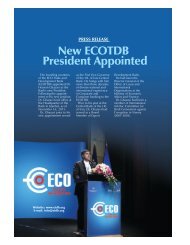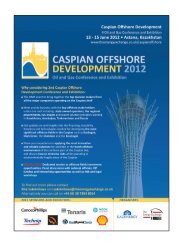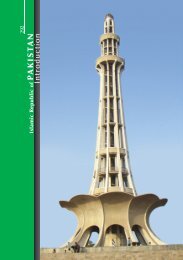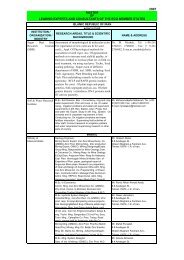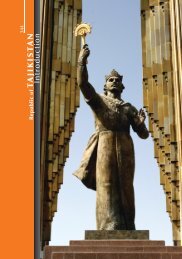ECO-IEST President, Alternative Member to the IPBES Bureau
ECO-IEST President, Alternative Member to the IPBES Bureau
ECO-IEST President, Alternative Member to the IPBES Bureau
Create successful ePaper yourself
Turn your PDF publications into a flip-book with our unique Google optimized e-Paper software.
Trade &<br />
Investment<br />
and construction sec<strong>to</strong>r because of weak domestic economic<br />
outlook and acute security situation. However as <strong>the</strong> economy<br />
stabilizes in <strong>the</strong> coming years and enters <strong>the</strong> growth phase of <strong>the</strong><br />
economic cycle <strong>the</strong> demand for cement is expected <strong>to</strong> pick up.<br />
This should be fur<strong>the</strong>r helped by extra demand from large scale<br />
infrastructure projects that would be taken up in near future<br />
such as Bhasha Dam and national highways. The reconstruction<br />
of flood affected areas and return of activity in <strong>the</strong> housing sec<strong>to</strong>r<br />
would also augment <strong>the</strong> demand.<br />
On <strong>the</strong> external side Pakistan has traditionally exported<br />
cement <strong>to</strong> Afghanistan, India, Gulf and African region countries.<br />
Afghanistan has accounted for over 30% of <strong>the</strong> cement exports<br />
of <strong>the</strong> country. This market is expected <strong>to</strong> remain attractive for<br />
Pakistani exports in <strong>the</strong> medium term. In India new production<br />
capacities have come on line in 2010 which would greatly<br />
reduce <strong>the</strong> prospects of exports <strong>to</strong> that country in near future.<br />
The Bank would support capacity enhancement and modernization<br />
projects in manufacturing sec<strong>to</strong>r. It would like <strong>to</strong> partner<br />
with o<strong>the</strong>r financial institutions in undertaking large projects.<br />
Pakistan Steel has also started an indigenization programme <strong>to</strong><br />
replace costly imported iron ore by locally available material.<br />
Expansion in <strong>the</strong> production capacity of Pakistan Steel <strong>to</strong> three<br />
metric <strong>to</strong>nnes per year or above has been planned. The plan is<br />
expected <strong>to</strong> be implemented in two phases and completed in<br />
around five years time. The steel re-rolling industry of <strong>the</strong> country<br />
is presently facing numerous problems as it is not getting raw<br />
material in sufficient quantity and utilizing only 40% capacity<br />
against normal use of 80 <strong>to</strong> 90%.Fur<strong>the</strong>r development and<br />
expansion on <strong>the</strong> steel production capacity requires security of<br />
investment, technical expertise, continuous availability of raw<br />
materials at reasonable prices, uninterrupted supply of electricity.The<br />
cement sec<strong>to</strong>r in Pakistan comprises of around 25 companies.<br />
The <strong>to</strong>p 4 players have more than 40% of <strong>the</strong> production<br />
capacity in <strong>the</strong> industry. The sec<strong>to</strong>r is divided in<strong>to</strong> <strong>the</strong> north<br />
and south zones. The former accounts for around 80% of <strong>the</strong><br />
current capacity and comprises of 19 plants, while <strong>the</strong> latter has<br />
20% of capacity with 10 plants. Domestic demand for cement<br />
hovers around 25 million metric <strong>to</strong>ns per annum and in <strong>the</strong> past<br />
years this sec<strong>to</strong>r has exported around 10 million metric <strong>to</strong>ns of<br />
cement <strong>to</strong> foreign countries. A number of companies launched<br />
capacity enhancement projects in <strong>the</strong> past few years and after<br />
completion of <strong>the</strong>se projects <strong>the</strong> capacity of <strong>the</strong> domestic<br />
cement industry is expected <strong>to</strong> be around 51 million metric <strong>to</strong>ns<br />
annually. The demand for cement has diminished domestically<br />
because of curtailing of public sec<strong>to</strong>r development programme<br />
under fiscal constraints and subdued activity in <strong>the</strong> real estate<br />
v)SMEs<br />
SMEs play a very significant role in <strong>the</strong> economy of Pakistan.<br />
They constitute nearly 90% of all <strong>the</strong> enterprises in Pakistan;<br />
employ 80% of <strong>the</strong> non-agricultural labor force; and <strong>the</strong>ir share<br />
in <strong>the</strong> annual GDP is around 40%. They also contribute around<br />
35% <strong>to</strong> manufacturing value addition and account for 25% of<br />
<strong>to</strong>tal exports. The size of <strong>the</strong> SMEs is generally small in <strong>the</strong> country<br />
with 5 or less people are working in 87% SMEs. In terms of<br />
business sec<strong>to</strong>rs, cot<strong>to</strong>n and textile are <strong>the</strong> leading sec<strong>to</strong>rs, followed<br />
by wood and furniture, fabricated metal products, beverages,<br />
carpets, art silk, and jewelry. The sec<strong>to</strong>r as a whole faces<br />
numerous challenges that include limited access <strong>to</strong> finance as<br />
well as limited support in improving business practices.<br />
International Labor Organization projects that economically<br />
active population in Pakistan is projected <strong>to</strong> increase from 63<br />
million in 2008 <strong>to</strong> 93 million in 2020. SMEs will be <strong>the</strong> main<br />
source of employment and poverty reduction in Pakistan that<br />
will create <strong>the</strong> value and innovation for <strong>the</strong> country in <strong>the</strong> days<br />
<strong>to</strong> come. Government could achieve its goal for poverty reduction,<br />
economic progress and above all <strong>the</strong> value creation by promoting<br />
SMEs. Pakistan needs <strong>to</strong> invest in its SMEs <strong>to</strong> improve <strong>the</strong><br />
value addition component of its products. It has been pointed<br />
out that Pakistan was converting one million bales of cot<strong>to</strong>n for<br />
USD 1 bln, while India was converting one million bales in<strong>to</strong><br />
USD 2 bln, and China USD 4 bln.<br />
According <strong>to</strong> business leaders, <strong>the</strong> biggest hurdle being faced<br />
by SMEs is limited access <strong>to</strong> finance. According <strong>to</strong> <strong>the</strong> reports of<br />
State Bank of Pakistan, SMEs financing by banks fell 6.6% <strong>to</strong><br />
USD 3.8 bln (Rs.326 bln) in March 2010 from USD 4.3 bln<br />
(Rs.349 bln) in March 2009. Federal government has allocated<br />
Rs 10 bln under venture capital fund for SMEs, while <strong>the</strong> government<br />
has also resolved <strong>to</strong> provide a 50% guarantee for <strong>the</strong><br />
credit <strong>to</strong> SME through banks. Some commercial banks have<br />
partnered with multilateral development agencies <strong>to</strong> deliver<br />
business skills' training programmes in finance, accounting, and<br />
o<strong>the</strong>r business practices <strong>to</strong> <strong>the</strong>ir SME cus<strong>to</strong>mers. According <strong>the</strong><br />
related bank officials, <strong>the</strong>se trainings have proved <strong>to</strong> be quite<br />
useful and effective and most of <strong>the</strong> trainees have started putting<br />
<strong>ECO</strong> CHRONICLE<br />
47



